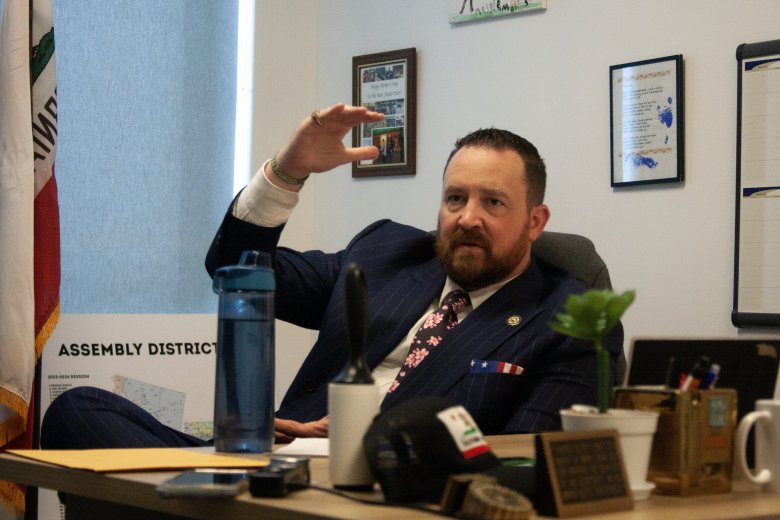What's at stake?
A majority of these unsafe water systems are in the Central Valley.
In spring, Erica Diaz stood in front of about a dozen people at the Orosi Branch Library in Tulare County and held up two water bottles: The first had unappealing murky water, while the second bottle was clear.
Diaz asked which they would choose to drink—a seemingly leading question. Turns out, the murky water was safer to drink than the clear water bottle which was contaminated with nitrates.
“A lot of people here in California are paying twice for water,” said Diaz, an advocate with the nonprofit Community Water Center, in a later interview. “Once for unsafe water, and then twice for … the bottle of water for their family.”
The nitrate sample was from East Orosi, where for years nitrate levels have exceeded limits.
A state audit from the California Water Resources Control Board released last year found that over 920,000 residents faced an increased risk of illness–including cancer, liver and kidney problems–due to consuming unsafe drinking water. A majority of these unsafe water systems are in the Central Valley.
The matter has prompted community leaders to mobilize residents around water quality as politicians confront imperfect solutions for the region’s supply. Advocates point out that impacted areas, including those in Tulare County, tend to be majority Latino with low median incomes.
Waukena Elementary School, a majority Latino and socioeconomically disadvantaged school, has had four nitrate contamination violations, according to a 2021 California State Water Resources Control Board Annual Compliance Report. At least another three elementary schools had water contamination violations.
This year’s extreme weather has only worsened the valley’s problems. The storms that hit California at the start of this year caused stormwater tainted with farm industry fertilizer, manure and nitrates to flow into valley aquifers.
All those problems are why, as head of the Community Water Center, Susana De Anda works across the Central Valley to educate and mobilize residents on water issues.
Years ago, while reading through water toxicity reports, De Anda noticed many of the water systems in her area were out of compliance.
She went door knocking in Tonyville, one of the noncompliant areas, where residents wanted to know: Is the water why people were getting sick?
“I don’t know,” she responded. “But what we could do is, I could call a meeting here. And we got to talk about water quality.”
She pushed residents to engage their water board. “The water board has the resources to solve this,” she said.
But building trust is not always so easy, advocates find.
In 2020, an arsenic treatment plant was installed in Alpaugh, a Tulare County town, after years of water contamination. Speaking with residents, some say they still do not trust the treated water and opt to purchase bottled water.
Of residents’ mistrust to treatment plans in general, CalEPA’s Deputy Secretary for Environmental Justice Moisés Moreno-Rivera said, “They remember the rashes, they remember the fear.”
De Anda said it’s taken a long time for her organization of 17 years to get the resources to be able to properly fight for safe and affordable drinking water.
“It took a long time to work within government agencies to recognize the importance of making sure that residents were part of the space,” she said.
Uncertainty lies in future solutions to unsafe water
The valley’s landscape itself poses a hurdle.
Assemblymember Devon Mathis (R-33, Visalia) points out that much of the region he serves – Fresno, Kings and Tulare counties – has a history of developing homes over farmland.
“All these old wells and things were ag[ricultural] wells,” Mathis said. “So those wells [developers] were going into, they weren’t looking to see, ‘Well, does this water have nitrates?’”
Mathis’ district is home to many water issues, including wells running dry from overpumping. Some solutions are underway, such as groundwater recharge programs and incentive programs for farmers to flood their land in hopes the water will percolate into the exhausted underground aquifers.

But while the recharge projects promise improved long-term groundwater security, California stewardship organization Sustainable Conservation raised concerns in a 2021 report about possible contamination. The land often used for recharge flooding is farmland, which has fertilizers and pesticides that may be transported with the water into aquifers, the report stated.
“People will need to make these difficult decisions together (e.g. temporary worse water quality in exchange for long term water security),” report authors wrote.
Speaking on water policy overall, Mathias said that solutions are “very dependent on the exact location and what’s going on in that situation.” He also said he favors speedier policies.
Since 2015, Mathis has scored low on his Sierra Club environmental scorecard–“a badge of honor in my area,” he said.
“The Sierra Club isn’t interested in solutions. They’re not interested in speeding up a process,” he added.
And with him being the vice-chair of Water, Parks, and Wildlife as well as Agriculture committees, his vote could hold sway.
As for De Anda, she encourages residents to lobby their local water provider. Without an outlet for their input, De Anda said, residents lack trust and there’s a higher chance of water misinformation spreading.
“They did not provide adequate translation for a lot of the hearings. So I would do all the translation,” she said. “We didn’t feel welcomed. We didn’t feel invited. We were forced to go and be heard.”
Aya Hashi and Jesse Morris are reporters with JCal, a collaboration between The Asian American Journalists Association and CalMatters to immerse high school students in California’s news industry.

